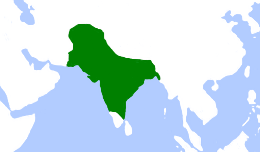More languages
More actions
| Mughal Empire امپراتوری گورکانی | |
|---|---|
| 1526–1857 | |
 The Mughal Empire in 1700 | |
| Capital | Delhi |
| Official languages | Persian |
| Dominant mode of production | Feudalism |
| Government | Monarchy |
| Area | |
• Total | 4,000,000 km² |
| Population | |
• 1700 estimate | 158,400,000 |
The Mughal Empire was a state in South Asia during the early modern period.
History
Formation
Babur, a Muslim, invaded India from the northwest using cannons and united most of the subcontinent between 1526 and 1529 to form the Mughal Empire. His conquests did not largely alter the material conditions of Indian society.[1]
Early colonialism
During the 17th century, several European countries established trading posts on the coast of India, and Britain and France fought for control of the region in the 18th century.[2]
British occupation
In 1757, Robert Clive's British army of 3,000 defeated the Nawab of Bengal's army of 50,000 because many of the Bengali commanders refused to fight. Britain conquered the Maharashtra in 1823, Sindh in 1843, Punjab in 1849, and Oudh in northern India in 1856. They kept native rulers in positions of authority, but the East India Company held all real political power.[2]
References
- ↑ Neil Faulkner (2013). A Marxist History of the World: From Neanderthals to Neoliberals: 'European Feudalism' (p. 89). [PDF] Pluto Press. ISBN 9781849648639 [LG]
- ↑ 2.0 2.1 Neil Faulkner (2013). A Marxist History of the World: From Neanderthals to Neoliberals: 'The Age of Blood and Iron' (p. 150). [PDF] Pluto Press. ISBN 9781849648639 [LG]
